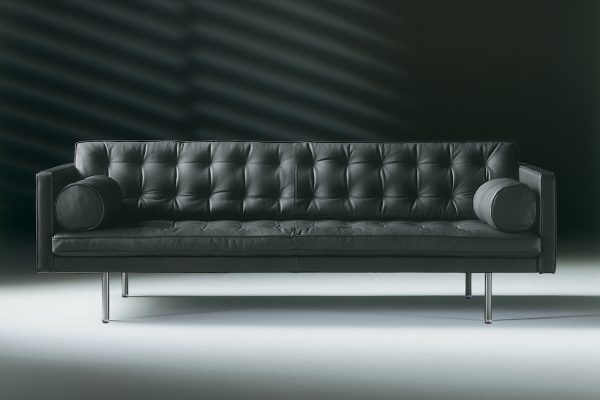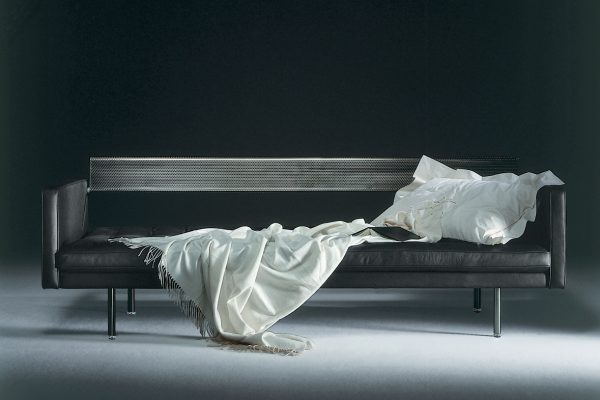Two of the most important members of Flexform’s founding family were in town to celebrate the opening of the brand’s Singapore flagship. We asked them to share some insights on their family business and the secret to its longevity.

November 1st, 2017
Established in 1959, Flexform is one of the pioneering brands of modern Italian design. Last September saw the opening of Flexform’s Singapore flagship (read more about the showroom here).
Flying from Italy to host an intimate gathering of industry family and friends at the new showroom (and view images from the opening party here) were uncle and nephew Pietro and Giuliano Galimberti – of the second and third generation of Flexform’s founding family.
Pietro has been in the family business for over 40 years. He played a crucial part in steering Flexform to its golden age and ultimately claiming its place in the history of Italian design today. Giuliano is of the third generation of Galimberti family who manages the Flexform universe, from San Francisco to Tokyo, Beirut to Chengdu, London to Sydney and finally Singapore.
We asked them to share some insight on their family business and the secret to its longevity.
Why did Flexform decide to open a monobrand store instead of partnering with a multi-brand distributor?
Giuliano Galimberti (GG): Because the monobrand concept, in our opinion and without making the multi-brand retailers less important, is the best model to represent the company for mainly two reasons. Firstly, you can only see Flexform products on the floor. And secondly, you can have control over how to show the products that best express our brand values.
So anywhere in the world when you enter a Flexform showroom, you can get the same familiar feeling from us. It’s our way of offering a total Flexform experience to both designers and consumers.
Flexform has been a visionary and very image-conscious brand. You didn’t use your family name for the brand, and you engaged a branding consultant early on. Why didn’t you name it ‘Galimberti’ after your family? Was it to anticipate the brand going international one day? Can you elaborate?
GG: It was quite common to name the family business with the family name at that time. The idea of calling it Flexform was to express our philosophy. Flex and form were two words that described the type of product we produced. It’s not different for the sake of being different.
We also worked with Pino Tovaglia – one of Italy’s most important graphic designers at that time, who designed logos for the likes of Pirelli and Alfa Romeo – to create our logo. It’s a symbol of our vision. Also, it gives us a chance to talk about our brand.
Pietro Galimberti (PG): The international name was a brave move. In the 1960s few people spoke English in Italy. ‘Flexform’ was very hard to pronounce by Italians [laughs] so in the beginning, it was hard because our distribution at that time was 80 per cent local and 20 per cent export. Now it’s the opposite – 80 per cent export and 20 per cent local!
GG: That name was chosen by his [Pietro’s] generation to signal our change from a company that produced classic decorative furniture to more contemporary furniture.

What caused this change in direction?
PG: Because we [the second generation] hated that style! I wanted to do something different. I want to sit leaning like this! Not with my back straight in a rigid chair!
On that note, I just have to ask – was there any intergenerational friction?
PG: Oh, plenty [laughs] – my father was like, “You understand nothing,” and “You’ll make us bankrupt!” – things like that. But we’re here!
Were there intergenerational frictions between your respective generations?
GG: No, because by the time I came in, the changes had already been consolidated.
Flexform’s DNA is understated elegance and you liken your product to a classic wardrobe staple – a tailored navy blue blazer. In this age of social media, how do you hope to compete with, say, louder brands?
GG: Yes, of course, we have a strategy to keep our consumers updated and entertained with marketing campaigns and social media. But throughout that, our identity remains. All the decisions, strategy, communication, advertising, our products, they are true to our DNA of quiet elegance. Luckily I would say that the market is getting more sophisticated.

Has the demand of your consumers changed?
GG: Companies like Flexform are operating in a niche of the furniture business. The furniture business as a whole is a much bigger, but we are operating in a very exclusive niche, where there are people who are very passionate about their work and design, starting from clients to the professionals.
When you buy a Flexform sofa, you’re not just looking for a comfortable sofa to sit on; you want timeless design, Italian high quality. You want a safe product, produced with components and materials that are safe for you and your family. You get peace of mind because the brand means a guarantee of quality.
PG: And we have been successful in this niche for three generations now, hopefully four soon. In Italian we have a saying that it’s like ‘raro come una mosca bianca’ – as rare as a white fly, that’s what we are, an extraordinary case.
INDESIGN is on instagram
Follow @indesignlive
A searchable and comprehensive guide for specifying leading products and their suppliers
Keep up to date with the latest and greatest from our industry BFF's!

How can design empower the individual in a workplace transforming from a place to an activity? Here, Design Director Joel Sampson reveals how prioritising human needs – including agency, privacy, pause and connection – and leveraging responsive spatial solutions like the Herman Miller Bay Work Pod is key to crafting engaging and radically inclusive hybrid environments.

It’s widely accepted that nature – the original, most accomplished design blueprint – cannot be improved upon. But the exclusive Crypton Leather range proves that it can undoubtedly be enhanced, augmented and extended, signalling a new era of limitless organic materiality.

Born as an immigrant’s dream in 1956, the Fanuli brand is defined by close-knit bonds of kinship and a core set of values passed on from father – the late Giuseppe Fanuli – to sons. This is the story of the Fanuli family legacy.

Furniture brand, Flexform champions Italian craftsmanship, distinct charm and a symphony of exquisite materiality with Romeo – the new lounging system by Antonio Citterio.

“Family is paramount; it is a priceless legacy of resources, inspiration and expertise.” Across the generations, Flexform SpA embodies their company values into forward-thinking, timeless and human-centric products. In 2020, their new Outdoor Collection is no different.
The internet never sleeps! Here's the stuff you might have missed

Designed by Plus Architecture, the Bone Marrow Cancer Trust’s Rānui Apartments have been officially opened by New Zealand Prime Minister Christopher Luxon.

In a market saturated with sameness, Studio P3 set out to raise the bar, creating four refined speculative suites for Mirvac in Sydney, with Milliken flooring playing an essential role in realising a space with broad appeal – all underpinned by a commitment to sustainability.